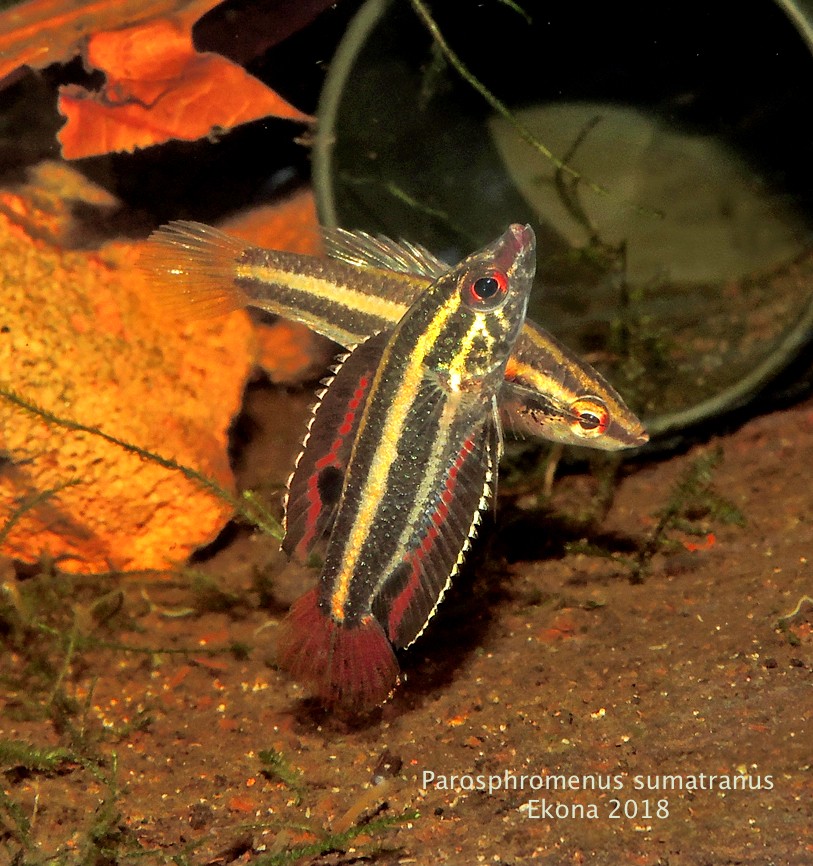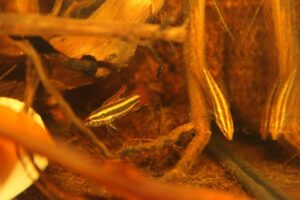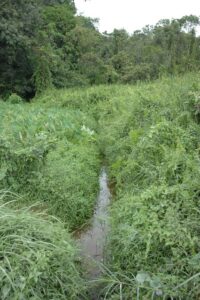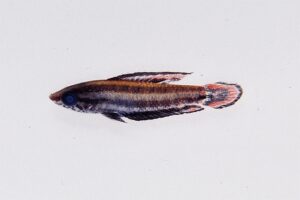
Parosphromenus sumatranus
Klausewitz 1955
First description: See- und Süßwasserfische von Sumatra und Java. Senckenbergiana Biologica, 36: 309-323
Characteristics: one of the most enigmatic Parosphromenus species, because it seems to occur in two structurally different variants, a form with a rather high back (normal type of licorice gourami) and a significantly leaner form with a relatively lower back (type lean licorice gourami, like ornaticauda/parvulus). It is unclear if these types represent the endpoint of a continuum or separate forms or varieties.
Total length max. 3.5 cm. Fin formula: Dorsal: XI-XII, 6-7, total 17-19, anal fin: X-XII, 8-10, total 20-22. The male shows in both fins, light red colour bands and in the rear part of the dorsal fin a species-typical round black dot, which can sometimes be found in the females as well, but here it appears to be less distinct. A narrow dark band, which runs along the border between body and anal fin is also typical for this species. This band is not present in other licorice gouramis, in this form. The caudal fin is monochrome pale red to black-red. The male also shows sometimes a very short (usually only 1 mm), single caudal filament – this occurs occasionally although less distinctly in females, too.
Similar species: Until its recognition as a separate species by Kottelat in 2005, sumatranus was regarded as a supspecies of the widespread P. deissneri. This species was subsequently mis-labelled repeatedly. In fact there is no risk of confusion, especially if the behaviour is considered. Head-up courtship appears apart from this species, only in P.ornaticauda and P.parvulus. P.sumatranus can not be confused with these two species, due to its fin and body colouration, which conforms to the main licorice gourami type. But even in pure phenotypic consideration, the risk of confusion is low, because the species shows characteristic particularities in its colouration (see above).
Occurrence / Distribution: endemic on Sumatra, Jambi district, e.g. near Leibong Sepbaju and in the river basins of Sungai Ayer Merah, Sungai Pijoan, Sungai Siak Kecil and Sungai Sentang.
Threat: Not known in detail, but surely given due to their endemic occurrence. Destruction of the licorice gourami habitats is a major threat also in Sumatra and thus sumatranus has to be regarded as endangered, too – like the other licorice gouramis.
Discovery/First import: the first describer, the ichthyologist Wolfgang Klausewitz from Frankfurt, described the species as a supposed subspecies of “deissneri”, based on fish that he found in an import.
Trade: both variants, with high and low back, occasionally have appeared in international trade, in recent years. Often they are not recognised as such, but receive partly misleading trade names for marketing reasons (“deissneri”, “red line”, fire red”, etc.).
Care / Breeding: just like other licorice gouramis. The species is very shy and needs hiding places. The tank set up has to consider this need. In suitable larger tanks simultaneous courtship and breeding of several couples can take place – this indicates a synchronisation in cohabiting groups. K. Koomans reported that 5 breeding pairs had courtship at the same time.
Behaviour / Particularities:Head-up courtship. Even a “tipped over” position is possible. This is the most striking feature of this species, together with the remarkable shyness, which is reported by many experts. The phenomenon of the presence two structurally different types (see above) is still completely unclear. Peter Finke has linked a particular hypothesis to this species concerning the evolution of the genus. It is the only Parosphromenus species, which combines features of the two large structure and behaviour types of licorice gouramis (“common type” vs. “ornaticauda/parvulus group”): from the first type the general body colouration (horizontal bands), as well as (principially) the colouration of dorsal and anal fin with bands, but from the latter it shows the slender body shape and the characteristic head-up courtship. This could be interpreted in a way that the two main groups have emerged from a sumatranus-like species, from which one group took the first named features, whereas the second developed the second group of characteristics. In some plant and animal groups several examples for such a evolutionary split have been recognised. If the same is the case for sumatranus, then this is indeed a particularly interesting species: the descendant of a primal licorice gourami.
Literature:
W. Klausewitz 1955: Parosphromenus deissneri – zum ersten Mal in Deutschland. DATZ 10: 257 f.
Weblinks:
PF





